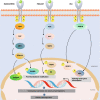Alternative splicing and cancer: a systematic review
- PMID: 33623018
- PMCID: PMC7902610
- DOI: 10.1038/s41392-021-00486-7
Alternative splicing and cancer: a systematic review
Abstract
The abnormal regulation of alternative splicing is usually accompanied by the occurrence and development of tumors, which would produce multiple different isoforms and diversify protein expression. The aim of the present study was to conduct a systematic review in order to describe the regulatory mechanisms of alternative splicing, as well as its functions in tumor cells, from proliferation and apoptosis to invasion and metastasis, and from angiogenesis to metabolism. The abnormal splicing events contributed to tumor progression as oncogenic drivers and/or bystander factors. The alterations in splicing factors detected in tumors and other mis-splicing events (i.e., long non-coding and circular RNAs) in tumorigenesis were also included. The findings of recent therapeutic approaches targeting splicing catalysis and splicing regulatory proteins to modulate pathogenically spliced events (including tumor-specific neo-antigens for cancer immunotherapy) were introduced. The emerging RNA-based strategies for the treatment of cancer with abnormally alternative splicing isoforms were also discussed. However, further studies are still required to address the association between alternative splicing and cancer in more detail.
Conflict of interest statement
The authors declare no competing interests.
Figures





References
Publication types
MeSH terms
Substances
LinkOut - more resources
Full Text Sources
Other Literature Sources
Medical

